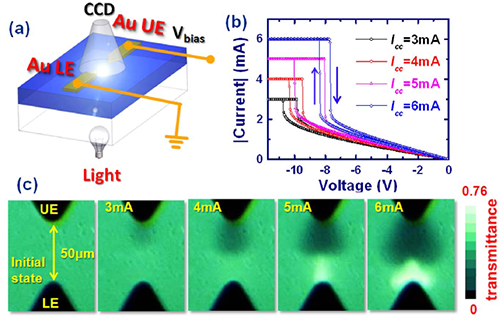Evolution of conduction channel and its effect on resistance switching in Au-WO3-x–Au devices
Date:04-03-2014 Print
Resistive switching (RS) in oxide-metal structures has attracted great attention for its prospective application in the next generation non-volatile memory, i.e., resistive random access memory (RRAM). A general consensus is that the RS effect stems from formation and rupture of conduction filaments (CFs) under the impact of electric field. Solid evidence for the presence of CFs was already obtained by various techniques. However, the dynamic behavior of the CFs in the process of the RS, which is crucially important for the performance improvement of the RRAM devices, has been scarcely investigated because of experimental difficulties.
Recently, a significant progress has been achieved. Combining photo microscopy with simultaneous electric measurements, HONG Deshun, a doctoral candidate in group M03 of the Institute of Physics, Chinese Academy of Sciences and his colleagues gave the first scenario about the evolution of CFs under the influence of electric stimulus and its effect on the memory character for the lateral Au-WO3-x-Au device. After systematic investigations, they found that in the first stage for electric forming, an electric structure consisted of a conductive channel (virtual cathode) started from cathode and an insulating band surrounding anode was formed, and the following SET/RESET operations affect device resistance mainly by modifying the CF across the insulating band, which is created in the SET process.
They further found that both the shape and conducting property of the CF remain essentially unchanged for repeated electric cycles, and electrode ablation, which occurs due to the electrochemical reaction between oxide and Au, is the main factor depressing device performance. Different from previously believed uniformity, fine electric structure was observed in the virtual cathode, indicated by the appearance and field-induced expansion/contraction of an insulating halo that separated the virtual cathode from the CF.
They further found that the virtual cathode and CF were oxygen-deficient areas, produced by the electromigration of oxygen anions, and repeated SET/RESET operations affect only the distribution of oxygen anions in the CF and the virtual cathode, and the total oxygen content is essentially unchanged. Possible approaches for the improvement of device performance were also proposed.
This work has been supported by the National Basic Research of China and the National Natural Science Foundation of China. Please refer to http://www.nature.com/srep/2014/140211/srep04058/full/srep04058.html
for the paper published in Scientific Reports.
CONTACT:
Prof. SUN Jirong
Institute of Physics
Chinese Academy of Sciences
Email: jrsun@iphy.ac.cn
 |
| Fig. 1 (a) Experiment setup, (b) I-V relations and (c) corresponding transmittance changes in optical images. (Image by IOP) |
 |
| Fig. 2 (a) I-V characteristics of the typical bipolar RS behavior. (b)~(l) In situ observation of the dynamic process for CF’s evolution. (Image by IOP) |
 |
| Fig. 3 AFM image shows the change in surface morphology of Au anode during the switching cycles. (Image by IOP) |

